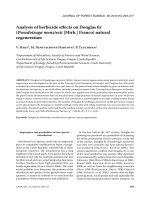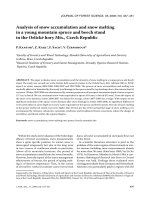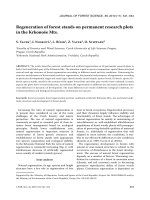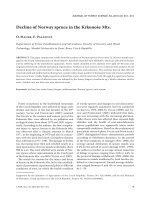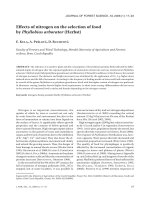Báo cáo lâm nghiệp: "Effects of spruce, beech and mixed commercial stand on humus conditions of forest soils" pdf
Bạn đang xem bản rút gọn của tài liệu. Xem và tải ngay bản đầy đủ của tài liệu tại đây (730.91 KB, 8 trang )
J. FOR. SCI., 55, 2009 (3): 119–126 119
JOURNAL OF FOREST SCIENCE, 55, 2009 (3): 119–126
e condition and form of humus in forest man-
agement are among key factors affecting the condi-
tion and growth of forest stands. In the course of the
last century, this fact was mentioned by prominent
specialists in the field of forest pedology, e.g. by
N (1928), M and K (1948), P
(1964), Š (1977, 1978). e function of forest
floor within the soil profile where the decomposi-
tion of plant and animal material and the subsequent
release of nutrients into the soil environment occur
can be considered to be fundamental. Differentia-
tion of forest floor horizons – forest litter, mull and
detritus where the particular processes of decompo-
sition, mineralization and humification take place,
is the result of humification. In the organo-mineral
horizon, the decomposition of dead rhizosphere (or
soil biota) and organic excrements occurs. Moreo-
ver, synthesized humus substances from surface
layers penetrate there (S, F 2007).
Chemical and physical properties of forest floor
layers and organo-mineral horizon show a crucial
effect on the site trophic properties and on the
biodiversity of forest ecosystems. us, through the
composition of forest stands and methods of their
growing we can affect the condition and properties
of the soil environment and, vice versa, plant com-
munities at the given site are directly dependent on
the soil environment quality. In recent decades, the
Supported by the Internal Grant Agency of Mendel University of Agriculture and Forestry in Brno within Project No. 32/2007
Research Plan No. 6215648902 of the Ministry of Education, Youth and Sports of the Czech Republic AVOZ 60870520 Gov-
ernmental Research Intention of the Institute of Systems Biology and Ecology, Academy of Sciences of the Czech Republic.
Effects of spruce, beech and mixed commercial stand
on humus conditions of forest soils
T. F
1
, L. M
1
, I. T
2
, J. K
1
1
Institute of Forest Ecology, Faculty of Forestry and Wood Technology,
Mendel University of Agriculture and Forestry in Brno, Brno, Czech Republic
2
Laboratory of Plants Ecological Physiology of Systems Biology and Ecology,
Academy of Sciences of the Czech Republic, Brno, Czech Republic
ABSTRACT: A pedological survey was carried out in a spruce monoculture, beech stand, and in a mixed stand at a
field research station in Rájec-Němčice of the Institute of Forest Ecology (IFE), Mendel University of Agriculture and
Forestry (MUAF) in Brno in the region of the Drahanská Upland in 2004–2006. e aim of the paper was to evaluate
(i) humus reserves and forms, (ii) soil reaction, (iii) reserves of total carbon and nitrogen for the forest floor layers
and (iv) carbon/nitrogen ratio. Soil analyses were carried out on samples taken at the end of the growing season in a
spruce, beech and mixed stand. e highest reserves of forest floor were found in the spruce stand (71.8 t/ha), which
also corresponded to the exchangeable soil reaction 3.3 ± 0.4, the C/N ratio being 27.3 ± 3.0. e lowest reserves were
found in the beech stand (46.7 t/ha), the soil reaction was 3.6 ± 0.5 and the C/N ratio was 26.0 ± 5.2. e mixed stand
represented an intermediate value between extreme positions.
Keywords: tree species composition; soil; forest floor reserves; humus forms; pH; C/N ratio
120 J. FOR. SCI., 55, 2009 (3): 119–126
problem of allochthonous spruce (Picea abies [L.]
Karst.) stands grown at sites outside the region of
natural range has been discussed. e majority of
the authors reported their effect on the soil envi-
ronment as negative (N 1928; P 1964;
K 1997). e humus of even-aged spruce
monocultures conditions the process of acidifica-
tion of the soil profile. is phenomenon was first
described and termed in the 80s as “new forest
decline” when U (1983) outlined possible
damage to forest stands due to acidification of soils.
Nevertheless, this theory has also its opponents,
e.g. Š (1978), who described acidification only
as a natural process which cannot be “taken out”
of the whole context of soil-forming processes and
who stated that it was not possible to attribute an
absolute effect to the process. Under conditions
of the Krkonoše Mts., E (1998) and E
et al. (2000) assessed borealization as a process of
natural acidification of soils and impoverishment of
basic cations. ey found that in spruce stands pH
values decreased by 0.2–0.3 and the base-exchange
complex was reduced even by 10% as compared
to beech stands. e problem of acidification has
acquired a new dimension particularly due to the
heavy air pollution load which has become evident
in the Krušné hory Mts. (Erzgebirge) since the
1950s (M 1963; H, C 2001).
At that time, mass forest decline occurred in moun-
tain regions as ecosystems with lower resistance to
air pollution changed the chemistry of precipitation
and atmospheric deposition (H, C
2001).
Health problems of spruce monocultures occur
not only due to the effects of pedological processes
mentioned above but also by means of a complex of
factors affecting spruce stands (fungal pathogens,
insect pests, abiotic effects such as wind, dry spell,
frost or the increasing general mean annual tempera-
ture in connection with the potential global change
of climate). Problems of spruce monocultures affect
seriously more European countries particularly with
respect to the new orientation of management and
use of forest ecosystems. In the Central-European re-
gion there is a large number of spruce monocultures
which are not adapted to a given site (S et al.
2004). e transformation of these forests to close-
to-nature forests, i.e. mixed stands, will enable to
reduce the risk of the stand disintegration effectively
(K, T 2004).
e aim of the paper was to evaluate conditions of
forest floor in relation to forest stands with changed
tree species composition on the Drahanská Upland.
Chemical analyses (such as pH, C/N ratio) and hu-
mus forms and layers were used to obtain required
information.
MATERIAL AND METHODS
Site and stand description
Pedological studies were carried out at the Rájec-
Němčice field research station of the Institute of
Forest Ecology, Mendel University of Agriculture
and Forestry in Brno, about 3 km north of the vil-
lage of Němčice (49°29'31''N and 16°43'30''E) and
on research plots of MP Forests of Benešov near
Boskovice, about 2.5 km north of the field research
station in the central part of the Drahanská Upland.
As for the type of topography, the area is included
in the broken uplands of deformed border slopes of
an arch megastructure. According to the topography
typological classification the area is ranked among
broken uplands of faulted structures and intrusive
rocks of the Bohemian Highland. Acid granodiorite
of the Brno massif is the parent rock of the area.
e soil profile is created on slope layers of various
depths with interspersed granodiorite gravel and
boulders here and there. Modal oligotrophic Cam-
bisol (N et al. 2001) is the soil type of the
area. e research plots are situated at an altitude of
600–660 m a.s.l. corresponding to a slightly warm
climatic region (Q 1971), with mean annual
air temperature 6.5°C and mean annual precipitation
717 mm (H 2002). e Forest Management
Institute in Brandýs nad Labem classified potential
Table 1. Short description of forest stands
Age Stand structure (%) Soil Forest typology
Spruce forest stand 110 SM 100
modal oligotrophic
Cambisol*
Cambisols (CM)**
5S1–Abieto-Fagetum
mesotrophicum with Oxalis
acetosella***Luzulo-Fagion
Beech forest stand 120 BK 100
Mixed forest stand 120 BK 55, SM 40, JD 5, MD, BO
*soil taxonomy by N et al. (2001), **WRB,
***taxonomy by FMI (Forest Management Institute, Brandýs nad Labem)
J. FOR. SCI., 55, 2009 (3): 119–126 121
growth conditions as Abieto-Fagetum mesotrophi-
cum with Oxalis acetosella.
However, we reason that the locality is situated at
the upper limit of the beech forest vegetation zone.
Brief characteristics of the research plots are given
in Table 1.
Sampling procedure
Samplings of forest floor for the reserve determi-
nation and subsequent analyses were always carried
out at the end of the growing season, in autumn,
after the leaf fall (Fagus sylvatica) in 2004–2006.
Particular samples were taken by a standard method
using a metal frame of a known area (0.1 m
2
). In each
of the three stands, 10 samplings of particular layers
(L, F, H) were carried out. Each sample was taken
separately. After transfer to the laboratory, the sam-
ples were dried up at 60°C to a constant weight in an
oven, weighed and mean dry weight was calculated
and subsequently reserves of forest floor per ha were
calculated. Samples of the organo-mineral horizon
(Ah horizon) were taken in autumn 2005 and 2006
in all three stands. At five places in each of the vari-
ants, pedological ditches were dug and by means of
a shovel and knife or a soil probe, Ah horizon was
taken. Horizons from each replication were taken
separately to a paper or plastic bag. Values of active
and exchangeable soil acidity were determined by a
potentiometer method (Z et al. 1997) using
a digital pH-meter OP-208/1 (Radelkis Budapest,
Hungary). It used a KCl solution of n = 1 mol/l for
assessment of exchange pH. Carbon and nitrogen
were determined from samples devoid of coarse
particles after fine grinding or comminution on a
LECO TruSpec analyzer (MI USA) (2006) (Z
et al. 1997).
Statistical analyses
Statistical analyses were carried out using the Sta-
tistica Program (Stat-Soft Inc., Tulsa USA). Single-
factor analysis ANOVA was used and Tukey’s test
was applied for the detection of differences between
groups. Significance was tested on the level α = 0.05.
Cluster analysis was used for the classification of
forest floor reserves.
RESULTS
Forest floor reserves
Forest floor reserves (Fig. 1) were determined in the
range from 46.7 to 71.8 t/ha and the forest floor depth
(L, F and H horizons) fluctuated between 5 and 8 cm.
e highest accumulation of forest floor occurred
under the stand in a 110-year spruce monoculture.
e lowest reserves occurred under the beech stand.
When comparing particular layers their reserves de-
creased from the H layer towards the L layer of litter.
e highest accumulation of humus in the H layer
occurs at the spruce stand locality. e mean reserve
of humus at the Rájec-Němčice field research station
of the IFE MUAF in Brno (the same area as the spruce
stand) in 1975 was in layers L 12.4 t/ha, F 15.8 t/ha
and H 21.7 t/ha. In 1982, he reported 11, 15.8 and
22.3 t/ha
in L, F and H layers, respectively and in 1990
Table 2. Statistically significant differences in forest floor reserves
Layer L F H
Stand spruce beech mixed spruce beech mixed spruce beech mixed
Spruce ** ** ** NS ** **
Beech ** NS ** NS ** NS
Mixed ** NS NS NS ** NS
*statistically significant differences (α < 0.05),
**
highly
statistically significant differences (α < 0.01), NS – not significant
Fig. 1. Stock of forest floor
0 10 20 30 40 50 60 70 80
Spruce
forest
stand
Beech
forest
stand
Mixed
forest
stand
(t/ha)
layer L
layer F
layer H
suma
Mixed Beech Spruce
forest forest forest
stand stand stand
122 J. FOR. SCI., 55, 2009 (3): 119–126
the values of exchangeable pH measured in the course
of 1975–1976 is evident (Fig. 5). Also in other data
related to the beech stand that are available (K
1997), it is possible to see the downward tendency of
soil reaction in the course of time (Fig. 6).
e content of total nitrogen in soil in 2004–2006
ranged about 1.45% for forest floor and about 0.2%
in the organo-mineral horizon A
h
in all stands. As for
total carbon, values range from 34.9% (beech stand)
to 41.3% (spruce stand), for humus layers L, F and
H from 3.3% (spruce stand) to 4.0% (beech stand) in
the organo-mineral horizon A
h
.
e highest reserves of carbon and nitrogen (Figs.
7 and 8) in forest floor occur in the spruce stand. e
lowest C/N ratio in forest floor (Fig. 9) occurs under
the 110-year spruce stand (26.0) and in the organo-
mineral horizon on the beech stand area. On the
contrary, the highest value was found in the beech
stand (27.3) in forest floor and in the spruce stand
A
h
horizon (20). e C/N ratio decreases from hori-
zon L to the organo-mineral horizon Ah.
In chemical analyses of pH, total carbon and
nitrogen and C/N ratio no statistically significant
differences were found.
DISCUSSION
e most important factors at the formation of
forest floor are: topography, climatic and microcli-
matic conditions, edaphon, soil chemistry and forest
stand or phytocoenosis composition (P 1964).
In this paper, particularly soil chemistry and forest
stand composition are studied. As for soil characte-
ristics, total carbon, total nitrogen, their ratio and
soil reaction were selected.
e main indicator of the biomass decomposition
rate is just the content of nitrogen and C/N ratio,
0
5
10
15
20
25
30
35
40
1975 Klimo 1982 Klimo 1980 - 1990
Šarman
2004 - 2006
Fabianek
(t/ha)
layer L layer F layer H
Fig. 2. Stock of forest floor in Spruce forest stand
the reserves in the particular layers were as follows:
L 9.9 t/ha, F 22.5 t/ha and H 20.5 t/ha (K, perso-
nal communication). Values determined in the course
of research are as follows: L 12.6 t/ha, F 25.5 t/ha
and H 33.8 t/ha. e humus form is the same in all
stands, see moder (N at al. 2001). Significant
differences in the particular layers of forest floor be-
tween stands are given in Table 2.
Chemical analyses
Values of actual (in H
2
O) and exchangeable pH (in
nKCl) were determined. Values of exchangeable pH
were always lower than those of actual pH. e ex-
changeable and actual reactions of soil (Figs. 3 and 4)
decreased from L to H in all stands. e lowest values
in forest floor (4.0 and 3.4) and in the organo-mineral
horizon A
h
(3.7 and 2.8) were determined at the spruce
stand locality where the actual soil reaction could be
specified as strongly acid or even very strongly acid.
For the spruce stand, data are available that were
obtained from the previous project measurements.
Already at first sight, a distinct downward tendency of
Fig. 4. Distribution of pH
KCl
in layers of forest floor and orga-
nomineral horizon in different forest stands
Fig. 3. Distribution of pH
H
2
O
in layers of forest floor and orga-
nomineral horizon in different forest stands
0 1 2 3 4 5 6
Spruce
forest
stand
Beech
forest
stand
Mixed
forest
stand
pH
layer L
layer F
layer H
Ah
Mixed Beech Spruce
forest forest forest
stand stand stand
0 1 2 3 4 5 6
Spruce
forest
stand
Beech
forest
stand
Mixed
forest
stand
pH
layer L
layer F
layer H
Ah
0 1 2 3 4 5
Spruce
forest
stand
Beech
forest
stand
Mixed
forest
stand
pH
layer L
layer F
layer H
Ah
Mixed Beech Spruce
forest forest forest
stand stand stand
0 1 2 3 4 5 6
Spruce
forest
stand
Beech
forest
stand
Mixed
forest
stand
pH
layer L
layer F
layer H
Ah
–
–
J. FOR. SCI., 55, 2009 (3): 119–126 123
which is given by the close relationship of the C/N
ratio and soil transformations of nitrogen (C
et al. 2000). In forest soils of Europe, the C/N ratio
ranges between 10 and 100 in the organic horizon,
the majority of the C/N ratio values occurring within
the limits 10 to 100, in mineral horizons within the
limits 10 to 30. However, the evaluation of the C/N
ratio is not so clear and differs between authors (V-
et al. 1982; B, G 1998; C
et al. 2000; P et al. 2000; P, U
2001). E et al. (1998) reported the critical
value of the C/N ratio in coniferous stands about 24.
At the ratio > 24, less than 10% nitrogen is washed
out from the ecosystem. Nevertheless, at the ratio
< 24, the amount of washed out nitrogen is higher
than 10% of the total nitrogen in the ecosystem. Val-
ues from forest floor in the coniferous stand do not
fall below the limit. e accumulation of nitrogen is
highest in the H layer, which is also the deepest layer
in all stands. Determined values of the C/N ratio in
the beech stand are a little lower than the values that
were measured in 1986–1987 in a comparable stand
situated at close vicinity (K 1997). In broad-
leaved stands, no limit values have been determined
to generalize assessing the C/N ratio for forest stands
(H, C 2001). e C/N ratio has to be
assessed using all analyses. M and K (1948)
reported pH values 3.7–4.5 for spruce humus. Simi-
larly, Š (1978) reported pH values 4.0–5.0 for co-
niferous litter. All stands show pH values lower than
the given range, which can be another factor indicat-
ing man-conditioned acidification of the soil profile.
According to the classification of buffer zones, the
spruce monoculture occurs predominantly in the
aluminium zone, which buffers the effects of acid
inputs through the release of Al
3+
under the presence
of sesquioxides and the simultaneous origin of or-
ganic complexes. Under these conditions, a gradual
decrease in the trophic potential occurs because of
slow accumulation of xenobiotic substances in the
0 1 2 3 4 5
L
F
H
Ah
p
H
1975 - 76
(Klimo)
1986 - 87
(Grunda)
1980 - 90
(Šarman)
2004 - 06
(Fabiánek
)
0 1 2 3 4 5
L
F
H
Ah
pH
1986 - 87
(Grunda)
2004 - 06
(Fabiánek
)
Fig. 5. pH
KCl
in layers of forest floor and
organomineral horizon of spruce forest
stand found by different authors
Fig. 7. Carbon stock in forest floor in different forest stands
Fig. 6. pH
KCl
in layers of forest floor and
organomineral horizon of beech forest
stand found by different authors
0 3 6 9 12 15 18 21 24 27
Spruce
forest
stand
Beech
forest
stand
Mixed
forest
stand
(t/h)
layer L
layer F
layer H
suma
Mixed Beech Spruce
forest forest forest
stand stand stand
)
)
–
–
–
–
–
–
124 J. FOR. SCI., 55, 2009 (3): 119–126
soil. Consequently, mineral nutrients are accessible
only to a limited extent and a risk of uncontrollable
washing out the organic colloids increases (U
1983). In the beech stand, pH values fluctuate around
the lower limit, namely 3.7–4.5 (M, K 1948)
and 5.0–6.5 (Š 1978). Comparing the present
exchangeable pH with pH values measured, there
occurred a decrease by about 10% (K 1997).
As for the division of soils according to the values of
soil reaction into particular buffer zones, soil under
the broadleaved stand falls to the exchangeable zone.
It is localized in soils where a disproportion occurs
between basic cations released in weathering feld-
spars and H
+
inputs. Under these conditions, pro-
tons could be immobilized at exchange sites of clay
minerals generally by Al
3+
sorption (U 1983).
Aluminium ions act partly as a weak acid and partly
toxically, thus limiting mycorrhizae. erefore, the
compensation of acid inputs within this zone occurs
particularly thanks to basic cations fixed at exchange
sites of organic colloids. e values of soil reaction
and the C/N ratio from soil samples of a mixed stand
are within the limits of the remaining two stands.
Carbon and nitrogen reserves are the lowest and
their accumulation in lower layers of the forest floor
does not take place.
e highest reserves and depth of forest floor were
found in the 110-years old spruce monoculture of
the second generation. e humus form consists of
moder (according to N et al. 2001) as well as
in the other two stands. As compared with previous
research there is an evident increase in material at
present, mainly in the H layer. e impairment of soil
condition probably occurred due to badly decom-
posable coniferous litter, which contains only a small
amount of nutrients (Z 1976; V B,
F 1998) and potentially increases acidification
throughout the soil profile. In the beech stand, a
smaller amount of material is accumulated. One of
the factors that support the accumulation is physi-
cal conditions. Between the L and F layers of forest
floor there is a layer of compacted undecomposed
leaf litter which is badly permeable for air and partly
also for water. In the mixed stand, the total reserve
and structure of forest floor approaches stands with
pure coniferous litter.
CONCLUSION
Within long-term monitoring in the course of
previous projects carried out by the Institute of
Forest Ecology on the Rájec nad Svitavou research
plot and in its close vicinity on comparable plots, it
was possible to assess soils under selected stands. In
studied stands there are soils with mainly acid soil
reaction and the moder humus form (according to
N et al. 2001). ese characteristics together
with reserves of carbon, nitrogen and C/N ratio in
forest floor indicate actual acidification affected by
human activities, not by the air pollution load but
by the method of management in forest ecosystems.
e effects of growing spruce monocultures are well
visible in the results of soil analyses. It refers to the
amount of accumulated material in layers of forest
floor, which is up to three times higher than in the
broadleaved stand. e values of soil reaction also
indicate higher acidity in the spruce monoculture
than in the beech stand. Regarding the conditions
of soil under the mixed stand (55% proportion of
beech), as compared with stands with pure broad-
leaved and pure coniferous litter, we can state that
its values range within the limits of these two mono-
cultures according to the majority of results of soil
characteristics.
Fig. 9. C/N ratio in forest floor in different forest stands
Fig. 8. Nitrogen stock in forest floor in different forest stands
0 5 10 15 20 25 30 35 40
Spruce
forest
stand
Beech
forest
stand
Mixed
forest
stand
C/N
layer L
layer F
layer H
Ah
Mixed Beech Spruce
forest forest forest
stand stand stand
0 5 10 15 20 25 30 35 40
Spruce
forest
stand
Beech
forest
stand
Mixed
forest
stand
C/N
layer L
layer F
layer H
Ah
0 0.1 0.2 0.3 0.4 0.5 0.6 0.7 0.8 0.9 1
Spruce
forest
stand
Beech
forest
stand
Mixed
forest
stand
(t/ha)
layer L
layer F
layer H
suma
Mixed Beech Spruce
forest forest forest
stand stand stand
J. FOR. SCI., 55, 2009 (3): 119–126 125
R e fe re n ce s
BINKLEY D., GIARDINA C., 1998.
Why do tree species
affect soil? e Warp and Woof of tree-soil interactions.
Biogeochemistry, 42: 89–106.
COTE L., BROWN S., PARE D., FYLES J., BAUHUS J., 2000.
Dynamics of carbon acid nitrogen mineralization in relation
to stand type, stand age and soil texture in the boreal mixed
wood. Soil Biology and Biochemistry, 32: 1079–1090.
EMMER I.M., 1998.
Methodology of humus form research.
Lesnictví-Forestry, 44: 16–22.
EMMER I.M., WESSEL W.W., KOOILMAN A., SEVINK J.,
FANTA J., 2000.
Restoration of degraded Central-Euro-
pean mountain forest soils under changing environmental
circumstances. In: KLIMO E., HAGER H., KULHAVÝ J.
(eds), Spruce Monocultures in Central Europe – Problems
and Prospects. EFI Proceedings, 23: 81–92.
EMMETT B.A ., BOXMAN D., BREDE MEIER M.,
GUNDERSEN P., KJONAAS O.J., MOLDAN F., SCHLEPPI
P., TIETEMA A., WRIGHT R.F., 1998.
Predicting the ef-
fects of atmospheric nitrogen deposition in conifer stands.
Evidence from the NITREX ecosystem scale experiments.
Ecosystem, 1: 352–360.
HADAŠ P., 2002. Temperature and precipitation condition in
the high elevation spruce stands of Drahanská vrchovina
upland. Ekológia (Bratislava), 21: 69–87.
HRUŠKA J., CIENCIALA E., 2001.
Dlouhodobá acidi-
fikace a nutriční degradace lesních půd – limitující faktor
současného lesnictví – I. Lesnická práce, 80: 494–495.
KLIMO E., TESAŘ V., 2004. Pěstování smrku u nás a v Evropě
– přednosti, rizika, způsoby. In: Sborník příspěvků ze
semináře Smrk – dřevina budoucnosti, Svoboda nad Úpou,
23.–24. 4. 2004. Hradec Králové, Lesy České republiky:
7–18.
KULHAVÝ J., 1997.
Acidifikace lesních půd jako půdní proces
a ekologický faktor. [Habilitační práce.] Brno, MZLU, Ústav
ekologie lesa: 96.
MAŘAN B., KÁŠ K., 1948.
Biologie lesa I – pedologie a mi-
krobiologie lesa. Praha, Melantrich: 573.
MATERNA J., 1963. Hnojení lesních porostů. Praha, SZN:
227.
NĚMEC A., 1928.
Studie o humifikaci lesních půd. Praha,
MZe RČS, 38: 239.
NĚMEČEK J., MACKŮ J., VOKOUN J., VAVŘÍČEK D., NO-
VÁK
. P., 2001. Taxonomický klasifikační systém půd České
republiky. Praha, ČZU: 79.
PELÍŠEK J., 1964.
Lesnické půdoznalství. Praha, SZN: 568.
PRESCOTT C.E., CHAPPELL H.N., VESTERDAL L., 2000.
Nitrogen turnover in forest floors of coastal Douglas-
fir at sites differing in soil nitrogen capital. Ecology, 81:
1878–1886.
PUHE J., ULRICH B., 2001.
Global climate change and hu-
man impacts on forest ecosystems. Ecological Studies,
143: 593.
QUITTE E., 1971.
Klimatické oblasti Československa. Brno,
Akademie: 73.
SAMEC P., FORMÁNEK P., 2007.
Mikrobiologie lesních půd.
Kostelec nad Černými lesy, Lesnická práce: 126.
SPIECKER
H., HANSEN J., KLIMO E., SKOVSGAARD J.P.,
STERBA H., VON TEUFFEL K., 2004. Norway Spruce
Conversion – Options and Consequences. Leiden – Bo-
ston, Brill: 269.
ŠÁLY R., 1977.
Lesnícke pôdoznalectvo. 2. vydanie. Zvolen,
VŠLD: 380.
ŠÁLY R., 1978.
Pôda – základ lesnej produkcie. Bratislava,
Príroda: 235.
ULRICH B., 1983.
Soil acidity and its relations to acid
deposition. In: Effects of Accumulation of Air Pollutants
in Forest Ecosystems. Proceedings of a Workshop Held
at Göttingen, West Germany 1982. Reidel, Dordrecht,
Springer: 127–146.
VAN BREEMEN N., FINZI A.C., 1998.
Plant-soil interac-
tions. Ecological aspects and evolutionary implications.
Biogeochemistry, 42: 1–19.
VITOUSEK P., GOSZ J.R., GRIER CH.C., MELILLO J.M.,
REINERS W.A., 1982.
A comparative analysis of potential
nitrification and nitrate mobility in forest ecosystems.
Ecological Monographs, 52: 155–177.
ZBÍRAL J., HONSA I., MALÝ S., 1997.
Analýza půd III.
Jednotné pracovní postupy. Brno, Ústřední kontrolní a zku-
šební ústav zemědělský.
ZLATNÍK A., 1976.
Lesnická fytocenologie. Praha, SZN:
495.
Received for publication July 23, 2008
Accepted after corrections October 17, 2008
Vliv smrkového, bukového a smíšeného hospodářského porostu
na humusové poměry lesních půd
ABSTRAKT: Pedologický průzkum probíhal ve smrkové monokultuře, bukovém porostu a smíšeném porostu
v letech 2004–2006 na výzkumném stacionáru Rájec-Němčice Ústavu ekologie lesa Mendelovy zemědělské a les
-
nické univerzity v Brně v oblasti Drahanské vrchoviny. Cílem práce bylo zhodnotit: (
i) zásobu a formu nadložního
126 J. FOR. SCI., 55, 2009 (3): 119–126
Corresponding author:
Ing. T F, Mendelova zemědělská a lesnická univerzita v Brně, Lesnická a dřevařská fakulta,
Ústav ekologie lesa, Lesnická 37, 613 00 Brno, Česká republika
tel./fax: + 420 545 134 180, e-mail:
humusu, (ii) půdní reakci, (iii) zásobu celkového uhlíku a dusíku pro vrstvy nadložního humusu a (iv) poměr uhlíku
a dusíku. Půdní analýzy byly provedeny ze vzorků odebraných na konci vegetačního období ve smrkovém, bukovém
a smíšeném porostu. Největší zásoba nadložního humusu byla zjištěna ve smrkovém porostu (71,8 t/ha), odpovídala
i výměnná půdní reakce 3,3 ± 0,4 a poměr uhlíku a dusíku byl 27,3 ± 3,0. Nejnižší zásoba byla zjištěna u bukového
porostu (46,7 t/ha), půdní reakce byla 3,6 ± 0,5 a poměr uhlíku a dusíku 26,0 ± 5,2. Smíšený porost reprezentoval
svými hodnotami půdních poměrů střed mezi krajními polohami.
Klíčová slova: dřevinná skladba; půda; zásoba nadložního humusu; forma humusu; pH; poměr C/N



